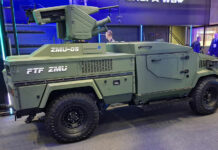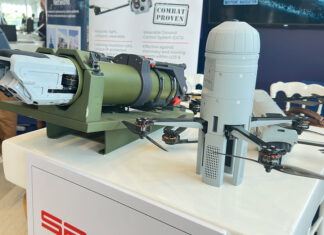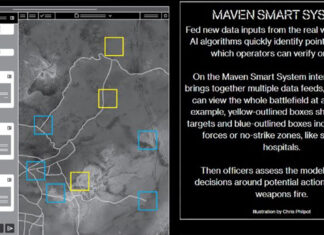Participating in the U.S. Army Expeditionary Warrior Experiment (AEWE) at Fort Benning, Ga. Last month, Northrop Grumman’s MQ-8B Fire Scout unmanned system demonstrated new mission capabilities provided by rotary-wing UAVs. Among the missions demonstrated by the Fire Scout were cargo delivery, force protection, area surveillance reconnaissance, and target acquisition (RSTA), broadband networking and communications relay. AEWE is an annual Army exercise designed to give soldiers a look at emerging battlefield technologies and concepts of operation.
Hovering 4,000 feet above the battlefield, Fire Scout offered soldiers both high fidelity video imagery produced by its electro-optical/infrared (EO/IR) sensor, and assured, Internet-like chat, file sharing and data transfers enabled by a Raytheon-produced communications payload.
One of the missions combined autonomous aerial and ground surveillance, performed by the Fire Scout and a Small Unmanned Ground Vehicle (SUG-V). On one such mission the Fire Scout flew to a specific area of interest, surveyed the area to ensure it was clear, and landed autonomously within its pre-planned landing point. When Fire Scout’s on-board skid sensors detected contact with the ground, a command was sent to release the unmanned ground vehicle. Once the SUGV deployed, the Fire Scout ascended and then loitered at a higher altitude to observe and provide a relay for commands between the UGV and its controller.
“Use of an unmanned system to carry other unmanned systems into battle could improve the speed of operations while protecting U.S. lives,” said Al Nikolaus, program manager of land-based Fire Scout at Northrop Grumman’s Aerospace Systems sector. “This demonstration provides another example of Fire Scout’s maturity, reliability, flexibility, and its ability to operate successfully with currently deployed systems.” said Nikolaus.
In addition to Fire Scout’s communications relay demonstration, the VUAS was used to support cargo resupply missions and to ferry other types of unmanned systems to troops operating in remote areas. For the communications relay missions, Fire Scout was equipped with a Mobile Ad hoc Interoperability Network GATEway (MAINGATE) communications payload. Installed in a pod attached to Fire Scout, the payload relayed communications among ground troops, allowing them to share high quality video, voice and data communications in real time. EO/IR surveillance imagery from the Fire Scout sensors was also fed into the MAINGATE network in real time, allowing soldiers to benefit from the VUAS’ “perch and stare” view of the battlefield.
On of the most significant aspects of the communications relay demo was how fast the payload was integrated on Fire Scout and flown successfully on multiple AEWE missions: ‘from start to finish, the process took less than three months; installation, check-out and first flight of the MAINGATE hardware at AEWE took just one day. The success of the MAINGATE demo reinforces the maturity and versatility of Fire Scout’s modular design” said Nikolaus.



















